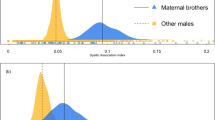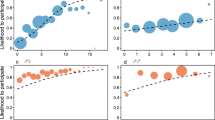Abstract
Theory predicts that frequent dyadic association should promote cooperation through kin selection or social tolerance. Here we test the hypothesis that sex differences in the strength and stability of association preferences among free-ranging chimpanzees conform to sex differences in cooperative behavior. Using long-term data from the Kanyawara chimpanzee (Pan troglodytes schweinfurthii) community (Kibale National Park, Uganda), we calculated indices of intra-sexual dyadic association over a 10-year period. We found that (1) male–male dyads had significantly stronger association indices than female–female dyads, (2) the pattern of association preferences in both sexes changed little over the entire study period, and (3) when comparing periods with different alpha males, changes in association strength were more frequent among males. These results demonstrate that both the strength and stability of association patterns are important components of social relationships. Male chimpanzees, which are characterized by frequent cooperation, had association preferences that were both strong and stable, suggesting that forming long-term bonds is an important dominance strategy. However, the fact that male association patterns were sensitive to upheaval in the male dominance hierarchy suggests that males also take advantage of a changing social climate when choosing association partners. By contrast, the overall strength of female associations was relatively weak. Female association preferences were equally stable as males’; however, this reflected a dyad’s tendency to be found in the same party rather than to associate closely within that party. Therefore, in this community, female association patterns appear to be more a consequence of individual ranging behavior rather than a correlate of cooperation.



Similar content being viewed by others
References
Alberts SC (1999) Paternal kin discrimination in wild baboons. Proc Roy Soc London, Ser B 266:1501–1506
Altmann J (1974) Observational study of behavior: sampling methods. Behaviour 49:227–267
Axelrod R, Hamilton WD (1981) The evolution of cooperation. Science 211:1390–1396
Baker KC, Smuts BB (1994) Social relationships of female chimpanzees: diversity between captive social groups. In: Wrangham RW, McGrew WC, de Waal FBM, Heltne PG (eds) Chimpanzee cultures. Harvard University Press, Cambridge, pp 227–242
Boesch C (1994) Cooperative hunting in wild chimpanzees. Anim Behav 48:653–667
Boesch C (2002) Cooperative hunting roles among Taï chimpanzees. Hum Nature-Int Bios 13:27–46
Bygott JD (1979) Agonistic behaviour, dominance and social structure in wild chimpanzees of the Gombe National Park. In: Hamburg DA, McCown ER (eds) The great apes. Benjamin/Cummings, Menlo Park, pp 405–427
Cairns SJ, Schwager SJ (1987) A comparison of association indices. Anim Behav 35:1454–1469
Clements KC, Stephens DW (1995) Testing non-kin cooperation: mutualism and the Prisoner’s Dilemma. Anim Behav 50:527–535
Connor RC, Heithaus MR, Barre LM (2001) Complex social structure, alliance stability and mating access in a bottlenose dolphin ‘super-alliance’. Proc Roy Soc London, Ser B 268:263–267
de Villiers MS, Richardson PRK, van Jaarsveld AS (2003) Patterns of coalition formation and spatial association in a social carnivore, the African wild dog (Lycaon pictus). J Zool (London) 260:377–389
de Waal FBM (1984) Sex differences in the formation of coalitions among chimpanzees. Ethol Sociobiol 5:239–255
de Waal FBM (1992) Coalitions as part of reciprocal relations in the Arnhem chimpanzee colony. In: Harcourt AH, de Waal FBM (eds) Coalitions and alliances in humans and other animals. Oxford University Press, Oxford, pp 233–257
de Waal FBM, Harcourt AH (1992) Coalitions and alliances: a history of ethological research. In: Harcourt AH, de Waal FBM (eds) Coalitions and alliances in humans and other animals. Oxford University Press, Oxford, pp 1–19
Duffy KG (2006) Social dynamics of male chimpanzees: adaptive significance of male bonds. PhD thesis, University of California, Los Angeles, Los Angeles, CA
Duffy KG, Silk JB, Wrangham RW (2007) Male chimpanzees exchange political support for mating opportunities. Curr Biol 17:R586–R587
Emery Thompson M, Kahlenberg SM, Gilby IC, Wrangham RW (2007) Core area quality is associated with variance in reproductive success among female chimpanzees at Kibale National Park. Anim Behav 73:501–512
Gilby IC (2006) Meat sharing among the Gombe chimpanzees: harassment and reciprocal exchange. Anim Behav 71:953–963
Gilby IC, Eberly LE, Pintea L, Pusey AE (2006) Ecological and social influences on the hunting behaviour of wild chimpanzees (Pan troglodytes schweinfurthii). Anim Behav 72:169–180
Gilby IC, Eberly LE, Wrangham RW (2008) Economic profitability of social predation among wild chimpanzees: individual variation promotes cooperation. Anim Behav 75:351–360
Goodall J (1986) The chimpanzees of Gombe: patterns of behavior. Harvard University Press, Cambridge
Hamilton WD (1964) The genetical evolution of social behavior. J Theor Biol 7:1–52
Hare B, Melis AP, Woods V, Hastings S, Wrangham RW (2007) Tolerance allows bonobos to outperform chimpanzees on a cooperative task. Curr Biol 17:619–623
Hemelrijk CK (1990) Models of, and tests for, reciprocity, unidirectionality and other social interaction patterns at a group level. Anim Behav 39:1013–1029
Kahlenberg SM, Emery Thompson M, Wrangham RW (2008) Female competition over core areas among Kanyawara chimpanzees, Kibale National Park, Uganda. Int J Primatol. In press
Kapsalis E (2003) Matrilineal kinship and primate behavior. In: Chapais B, Berman C (eds) Kinship and behavior in primates. Oxford University Press, Oxford, pp 153–176
Langergraber KE, Mitani JC, Vigilant L (2007) The limited impact of kinship on cooperation in wild chimpanzees. Proc Natl Acad Sci USA 104:7786–7790
Lehmann J, Boesch C (2007) Sexual differences in chimpanzee sociality. Int J Primatol 29:65–81
Mantel N (1967) The detection of disease clustering and a generalized regression approach. Cancer Res 27:209–200
Melis AP, Hare B, Tomasello M (2006) Engineering cooperation in chimpanzees: tolerance constraints on cooperation. Anim Behav 72:275–286
Mesterton-Gibbons M, Dugatkin LA (1992) Cooperation among unrelated individuals: evolutionary factors. Q Rev Biol 67:267–281
Mitani JC (2005) Reciprocal exchange in chimpanzees and other primates. In: Kappeler PM, van Schaik CP (eds) Cooperation in primates: mechanisms and evolution. Springer, Heidelberg, pp 101–113
Mitani JC, Merriwether DA, Zhang C (2000) Male affiliation, cooperation and kinship in wild chimpanzees. Anim Behav 59:885–893
Mitani JC, Watts DP (2001) Why do chimpanzees hunt and share meat. Anim Behav 61:915–924
Mitani JC, Watts DP, Pepper JW, Merriwether DA (2002) Demographic and social constraints on male chimpanzee behaviour. Anim Behav 64:727–737
Muller MN, Mitani JC (2005) Conflict and cooperation in wild chimpanzees. Adv Stud Behav 35:275–331
Murray CM, Mane SV, Pusey AE (2007) Dominance rank influences female space use in wild chimpanzees, Pan troglodytes: towards an ideal despotic distribution. Anim Behav 74:1795–1804
Newton-Fisher NE (1999) Association by male chimpanzees: a social tactic. Behaviour 136:705–730
Newton-Fisher NE (2002) Relationships of male chimpanzees in the Budongo Forest, Uganda. In: Boesch C, Hohmann G, Marchant L (eds) Behavioural diversity in chimpanzees and bonobos. Cambridge University Press, Cambridge, pp 112–124
Nishida T (1968) The social group of wild chimpanzees in the Mahali mountains. Primates 9:167–224
Nishida T (1983) Alpha status and agonistic alliance in wild chimpanzees (Pan troglodytes schweinfurthii). Primates 24:318–336
Nishida T, Hosaka K (1996) Coalition strategies among adult male chimpanzees of the Mahale Mountains, Tanzania. In: McGrew WC, Marchant L, Nishida T (eds) Great ape societies. Cambridge University Press, Cambridge, pp 114–134
Pepper JW, Mitani JC, Watts DP (1999) General gregariousness and specific social preferences among wild chimpanzees. Int J Primatol 20:613–632
Pusey AE, Williams JM, Goodall J (1997) The influence of dominance rank on the reproductive success of female chimpanzees. Science 277:828–831
Riss D, Goodall J (1977) The recent rise to the alpha-rank in a population of free-living chimpanzees. Folia Primatol 27:134–151
Silk JB, Alberts SC, Altmann J (2006a) Social relationships among adult female baboons (Papio cynocephalus) II. Variation in the quality and stability of social bonds. Behav Ecol Sociobiol 61:197–204
Silk JB, Altmann J, Alberts SC (2006b) Social relationships among adult female baboons (Papio cynocephalus) I. Variation in the strength of social bonds. Behav Ecol Sociobiol 61:183–195
Stanford CB (1998) Chimpanzee and red colobus. Harvard University Press, Cambridge
Swofford DL (2003) PAUP*: phylogenetic analysis using parsimony (*and other methods), 4th edn. Sinauer Associates, Sunderland
Townsend SW, Slocombe KE, Emery Thompson M, Zuberbühler K (2007) Female-led infanticide in wild chimpanzees. Curr Biol 17:R355–R356
Trivers RL (1971) The evolution of reciprocal altruism. Q Rev Biol 46:35–57
Vigilant L, Hofreiter M, Siedel H, Boesch C (2001) Paternity and relatedness in wild chimpanzee communities. Proc Natl Acad Sci USA 98:12890–12895
Watts DP (1998) Coalitionary mate guarding by male chimpanzees at Ngogo, Kibale National Park, Uganda. Behav Ecol Sociobiol 44:43–55
Watts DP (2002) Reciprocity and interchange in the social relationships of wild male chimpanzees. Behaviour 139:343–370
Watts DP, Mitani JC (2001) Boundary patrols and intergroup encounters in wild chimpanzees. Behaviour 138:299–327
Watts DP, Muller MN, Amsler SJ, Mbabazi G, Mitani JC (2006) Lethal intergroup aggression by chimpanzees in Kibale National Park, Uganda. Am J Primatol 68:161–180
Williams JM (2000) Female strategies and the reasons for territoriality in chimpanzees: lessons from three decades of research at Gombe. PhD thesis, University of Minnesota, Minneapolis, MN
Williams JM, Pusey AE, Carlis JV, Farm BP, Goodall J (2002a) Female competition and male territorial behaviour influence female chimpanzees’ ranging patterns. Anim Behav 63:347–360
Williams JM, Liu H-Y, Pusey AE (2002b) Costs and benefits of grouping for female chimpanzees at Gombe. In: Boesch C, Hohmann G, Marchant L (eds) Behavioural diversity in chimpanzees and bonobos. Cambridge University Press, Cambridge, pp 192–203
Wilson ML (2001) Imbalances of power: how chimpanzees respond to the threat of intergroup aggression. PhD thesis, Harvard University, Cambridge, MA
Wilson ML, Wrangham RW (2003) Intergroup relations in chimpanzees. Ann Rev Anthropol 32:363–392
Wilson ML, Hauser MD, Wrangham RW (2001) Does participation in intergroup conflict depend on numerical assessment, range location or rank for wild chimpanzees. Anim Behav 61:1203–1216
Wilson ML, Wallauer WR, Pusey AE (2004) New cases of intergroup violence among chimpanzees in Gombe National Park, Tanzania. Int J Primatol 25:523–549
Wrangham RW (2000) Why are male chimpanzees more gregarious than mothers? A scramble competition hypothesis. In: Kappeler PM (ed) Primate males: causes and consequences of variation in group composition. Cambridge University Press, Cambridge, pp 248–258
Wrangham RW, Smuts B (1980) Sex differences in the behavioral ecology of chimpanzees in the Gombe National Park, Tanzania. J Reprod Fertil, Supplement 28:13–31
Wrangham RW, Clark AP, Isabirye-Basuta G (1992) Female social relationships and social organization of Kibale forest chimpanzees. In: Nishida T, McGrew WC, Marler P, Pickford M, de Waal FBM (eds) Topics in primatology. Vol. 1. Human origins. Tokyo University Press, Tokyo, pp 81–98
Acknowledgements
Long-term research at Kanyawara was supported by funding from NSF Grant 0416125 to R. Wrangham. I. Gilby was also partially supported by NSF Grant IIS-0431141. We thank the Uganda National Council for Science and Technology, the Uganda Wildlife Authority, and the Makerere University Biological Field Station for permission to conduct research within Kibale National Park. This research complies with the current laws of Uganda. This project would not have been possible without the hard work and dedication of the field research team, especially Francis Mugurusi, Christopher Muruuli, Peter Tuhairwe, Christopher Katongole, and the late Donor Muhangyi and John Barwogeza, as well as field managers Michael Wilson, Martin Muller, Katherin Pieta, Carole Hooven, Kimberly Duffy, Alain Houle, and Emily Otali. Thanks also to Kate Burmon for tireless data entry, Randall Collura for assistance with the phylograms, and to David Watts, Zarin Machanda, Melissa Emery Thompson, Meg Crofoot, Kimberly Duffy, and two anonymous reviewers for comments on earlier versions of this manuscript.
Author information
Authors and Affiliations
Corresponding author
Additional information
Communicated by D. Watts
Rights and permissions
About this article
Cite this article
Gilby, I.C., Wrangham, R.W. Association patterns among wild chimpanzees (Pan troglodytes schweinfurthii) reflect sex differences in cooperation. Behav Ecol Sociobiol 62, 1831–1842 (2008). https://doi.org/10.1007/s00265-008-0612-6
Received:
Revised:
Accepted:
Published:
Issue Date:
DOI: https://doi.org/10.1007/s00265-008-0612-6




